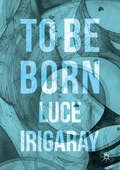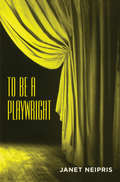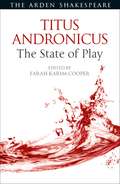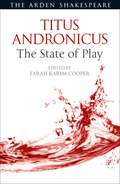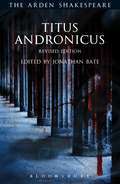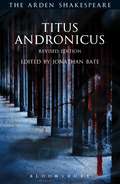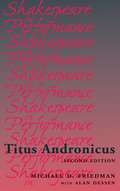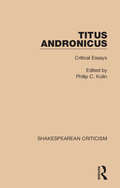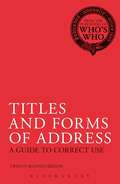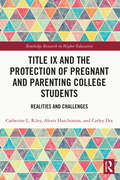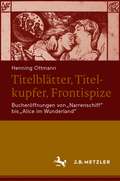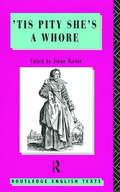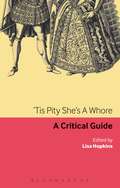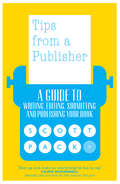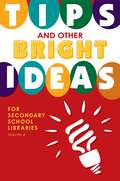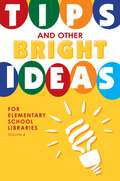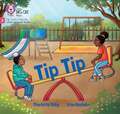- Table View
- List View
To Be Born: Genesis of a New Human Being
by Luce Irigaray“According to the words of Phaedrus in the Symposium of Plato, Love, sometimes named Eros, has no parents, no age, no history, and its origin remains unknown to anyone. Love, whose destiny is said to be unique amongst the gods and humans, perhaps embodies desire for a conjunction always in search of its happening. Love would represent a dynamism longing for the copula incarnating the transcendence of our being. As such, Love would remain the everlasting yearning for the accomplishment of the ecstatic destiny of humanity.” In this book, Luce Irigaray - philosopher, linguist, psychologist and psychoanalyst - proposes nothing less than a new way of conceiving what a human being is as well as a means to ensure our individual and relational development from birth. Unveiling the mystery of our origin is probably what most motivates our quests and plans. And yet such a disclosure proves to be impossible. Indeed we were born as one from a union between two, and we are forever deprived of an origin of our own. Hence our ceaseless search for roots: in our genealogy, in the place where we were born, in our culture, religion or language. But a human being cannot develop from its own roots as a tree does. As humans, we must take responsibility for our own being and existence without any given continuity with our origin and background. How can we achieve that? First by cultivating our breathing, which is more than a means to come into the world and to exist; breathing also allows us to transcend mere survival to secure for ourselves a spiritual becoming. Taking on our sexuate belonging is the second element which enables us to assume our natural existence. Indeed, this determination at once brings us energy and provides us with a structure which contributes to our individuation and our relations with other living beings and the world. Our sexuation can compensate for our absence of roots too by compelling us to unite with the other sex so that we freely approach the copulative conjunction from which we were born; that is, the mystery of our origin. This does not occur through a mere sexual instinct or drive, but requires us to cultivate desire and love with respect for our mutual difference(s). In this way we can give rise to a new human being, not only at a natural but also at an ontological level.
To Be a Playwright
by Janet NeiprisFirst Published in 2006. Routledge is an imprint of Taylor & Francis, an informa company.
To Be a Playwright
by Janet NeiprisFirst Published in 2006. Routledge is an imprint of Taylor & Francis, an informa company.
Titus Andronicus: The State of Play (Arden Shakespeare The State of Play)
by Farah Karim CooperShakespeare's and Peele's Titus Andronicus has had a theatrical and a critical revival in the last fifteen years; the critical revival was perhaps prompted by Jonathan Bate's Arden edition of the play and its revision of the traditional critical account that it is an immature work and overly sensationalistic with its emphasis on non-essential violence. Recent debates and approaches have drawn closer attention to the play's classicism; re-defined its genre (for example the revised edition of the New Dramatic Sources will re-classify the play as one of Shakespeare's Roman plays); re-considered the nature of violent spectacle, family relations and kinship, political alliance, race and miscegenation. This study will explore how the revitalized critical responses to early modern and contemporary performance histories has had a significant impact upon the wider reception of this play.
Titus Andronicus: The State of Play (Arden Shakespeare The State of Play)
by Farah Karim CooperShakespeare's and Peele's Titus Andronicus has had a theatrical and a critical revival in the last fifteen years; the critical revival was perhaps prompted by Jonathan Bate's Arden edition of the play and its revision of the traditional critical account that it is an immature work and overly sensationalistic with its emphasis on non-essential violence. Recent debates and approaches have drawn closer attention to the play's classicism; re-defined its genre (for example the revised edition of the New Dramatic Sources will re-classify the play as one of Shakespeare's Roman plays); re-considered the nature of violent spectacle, family relations and kinship, political alliance, race and miscegenation. This study will explore how the revitalized critical responses to early modern and contemporary performance histories has had a significant impact upon the wider reception of this play.
Titus Andronicus: Revised Edition (The Arden Shakespeare Third Series)
by Jonathan BateTitus Andronicus is one of Shakespeare's earliest and bloodiest tragedies and was hugely successful in his lifetime. Subsequent generations have struggled with its bold confrontation of violence but in the 20th and 21st centuries the play has chimed with audiences again, perhaps because of its simultaneously shocking and playful approach to violent revenge and bodily mutilation. Jonathan Bate's original Arden edition was first published in 1995 and has had a significant influence on how the play has been performed and studied in the past 20 years. This revised edition includes a new 10,000 word introductory essay in which Bate reassess his views on the play's co-authorship with George Peele in the light of contemporary textual scholarship and updates his lively account of the play's performance history, on the international stage and screen. With detailed on-page commentary notes this will continue to be the edition of choice for students, scholars and theatre-makers.
Titus Andronicus: Revised Edition (The Arden Shakespeare Third Series)
by Jonathan BateTitus Andronicus is one of Shakespeare's earliest and bloodiest tragedies and was hugely successful in his lifetime. Subsequent generations have struggled with its bold confrontation of violence but in the 20th and 21st centuries the play has chimed with audiences again, perhaps because of its simultaneously shocking and playful approach to violent revenge and bodily mutilation. Jonathan Bate's original Arden edition was first published in 1995 and has had a significant influence on how the play has been performed and studied in the past 20 years. This revised edition includes a new 10,000 word introductory essay in which Bate reassess his views on the play's co-authorship with George Peele in the light of contemporary textual scholarship and updates his lively account of the play's performance history, on the international stage and screen. With detailed on-page commentary notes this will continue to be the edition of choice for students, scholars and theatre-makers.
Titus Andronicus (Shakespeare in Performance)
by Michael FriedmanMichael D. Friedman’s second edition of this stage history of Shakespeare’s Titus Andronicus adds an examination of twelve major theatrical productions and one film that appeared in the years 1989–2009. Friedman identifies four lines of descent in the recent performance history of the play: the stylised, realistic, darkly comic, and political approaches, which culminate in Julie Taymor’s harrowing film Titus (1999). Aspects of Taymor’s eclectic vision of ancient Rome under the grip of modern fascism were copied by several subsequent productions, making Titus the most characteristic, as well as the most influential, contemporary performance of the play. Friedman’s work extends Alan Dessen’s original study to include Taymor’s film, along with chapters devoted to the efforts of international directors including Gregory Doran, Silviu Purcarete, and Yukio Ninagawa. This expanded volume will prove essential to students of Shakespeare’s play, along with scholars interested in the tragedy’s gruesome yet occasionally comical performance history.
Titus Andronicus (Shakespeare in Performance)
by Michael FriedmanMichael D. Friedman’s second edition of this stage history of Shakespeare’s Titus Andronicus adds an examination of twelve major theatrical productions and one film that appeared in the years 1989–2009. Friedman identifies four lines of descent in the recent performance history of the play: the stylised, realistic, darkly comic, and political approaches, which culminate in Julie Taymor’s harrowing film Titus (1999). Aspects of Taymor’s eclectic vision of ancient Rome under the grip of modern fascism were copied by several subsequent productions, making Titus the most characteristic, as well as the most influential, contemporary performance of the play. Friedman’s work extends Alan Dessen’s original study to include Taymor’s film, along with chapters devoted to the efforts of international directors including Gregory Doran, Silviu Purcarete, and Yukio Ninagawa. This expanded volume will prove essential to students of Shakespeare’s play, along with scholars interested in the tragedy’s gruesome yet occasionally comical performance history.
Titus Andronicus: Critical Essays (Shakespearean Criticism)
by Philip C. KolinOriginally published in 1995. In three parts – introduction, criticism and reviews – this volume examines the goriest of Shakespeare’s works. The editor’s exhaustive introduction runs through the pattern of changing scholarship and commentary, introducing the key interests in the play, from its authorship to its language, rhetoric and performance. Early commentaries focused on arguing about whether the play was truly Shakespeare’s. A selection of the most important of these are included here followed by later investigations looking at myriad topics and characters – revenge, violence, race, Aaron, women, tragedy and Tamora. The large section of reviews of stage performances, arranged chronologically, ranges from 1857 to 1990. Two final pieces interestingly survey stage history of Titus in Japan and in Germany.
Titus Andronicus: Critical Essays (Shakespearean Criticism)
by Philip C. KolinOriginally published in 1995. In three parts – introduction, criticism and reviews – this volume examines the goriest of Shakespeare’s works. The editor’s exhaustive introduction runs through the pattern of changing scholarship and commentary, introducing the key interests in the play, from its authorship to its language, rhetoric and performance. Early commentaries focused on arguing about whether the play was truly Shakespeare’s. A selection of the most important of these are included here followed by later investigations looking at myriad topics and characters – revenge, violence, race, Aaron, women, tragedy and Tamora. The large section of reviews of stage performances, arranged chronologically, ranges from 1857 to 1990. Two final pieces interestingly survey stage history of Titus in Japan and in Germany.
Titles and Forms of Address: A Guide to Correct Use
by Bloomsbury PublishingA guide to correct forms of address in speech and correspondence. It covers both formal and social occasions, and includes the forms of address for bishops, peers, privy counsellors, ambassadors, JPs and mayors. Where honours, decorations and degrees appear after the name as letters, an explanation and the correct sequence is given. This edition is revised and updated to cover changing conventions.Now in its 22nd edition, this book has been in constant demand for over 85 years.
Titles and Forms of Address: A Guide to Correct Use
by Bloomsbury PublishingA guide to correct forms of address in speech and correspondence. Itcovers both formal and social occasions, and includes the forms ofaddress for bishops, peers, privy counsellors, ambassadors, JPs andmayors. Where honours, decorations and degrees appear after the name asletters, an explanation and the correct sequence is given. This editionis revised and updated to cover changing conventions.Now in its 22nd edition, this book has been in constant demand for over 85 years.
Title Updated: Genes, Race, And History (Object Lessons)
by Kati StevensObject Lessons is a series of short, beautifully designed books about the hidden lives of ordinary things. The electric candle and faux fur, coffee substitutes and meat analogues, Obama impersonators, prosthetics. Imitation this, false that. Humans have been replacing and improving upon the real thing for millennia – from wooden toes found on Egyptian mummies to the Luxor pyramid in Las Vegas. So why do people have such disdain for so-called “fakes”? Kati Stevens's Fake discusses the strange history of imitations, as well as our ever-changing psychological and socioeconomic relationships with them. After all, fakes aren't going anywhere; they seem to be going everywhere. Object Lessons is published in partnership with an essay series in The Atlantic.
Title IX and the Protection of Pregnant and Parenting College Students: Realities and Challenges (Routledge Research in Higher Education)
by Catherine L. Riley Alexis Hutchinson Carley DixThis book explores the discrepancies among what protections Title IX provides to pregnant and parenting students, what colleges communicate, and what pregnant and parenting students actually experience. To actually protect pregnant and parenting students, the authors argue that a school must provide multifaceted support that is effectively communicated to an entire campus community, including students who are parenting, who are pregnant, and who may become pregnant. The first part of the book portrays the realities of pregnancy and parenting in college. The chapters illuminate related Title IX applications, population demographics, how unplanned pregnancies in college occur, and physical and mental health challenges that these students often experience. The authors then discuss what compliance with Title IX legally entails and why meeting it is often an afterthought. In the second half of the book, the authors use mixed-methods research to map the compliance landscapes of three schools in the southeast as examples: a large state school, a mid-size private university, and a small private college. Offering eye-opening interviews with pregnant and parenting students, interdisciplinary research, and proposals for multifaceted support and communication on college campuses, this volume will engage students, scholars, and activists with an interest in higher education administration, educational policy, reproductive health, bioethics, gender studies, and rhetoric.
Title IX and the Protection of Pregnant and Parenting College Students: Realities and Challenges (Routledge Research in Higher Education)
by Catherine L. Riley Alexis Hutchinson Carley DixThis book explores the discrepancies among what protections Title IX provides to pregnant and parenting students, what colleges communicate, and what pregnant and parenting students actually experience. To actually protect pregnant and parenting students, the authors argue that a school must provide multifaceted support that is effectively communicated to an entire campus community, including students who are parenting, who are pregnant, and who may become pregnant. The first part of the book portrays the realities of pregnancy and parenting in college. The chapters illuminate related Title IX applications, population demographics, how unplanned pregnancies in college occur, and physical and mental health challenges that these students often experience. The authors then discuss what compliance with Title IX legally entails and why meeting it is often an afterthought. In the second half of the book, the authors use mixed-methods research to map the compliance landscapes of three schools in the southeast as examples: a large state school, a mid-size private university, and a small private college. Offering eye-opening interviews with pregnant and parenting students, interdisciplinary research, and proposals for multifaceted support and communication on college campuses, this volume will engage students, scholars, and activists with an interest in higher education administration, educational policy, reproductive health, bioethics, gender studies, and rhetoric.
Titelblätter, Titelkupfer, Frontispize: Bucheröffnungen von "Narrenschiff" bis "Alice im Wunderland"
by Henning OttmannWer Hobbes‘ Leviathan in Händen hält und findet das Titelblatt nicht, ist mit recht enttäuscht. Henning Ottmann widmet sich in diesem Buch den Frontispizen und Titelblättern, die über mehrere Jahrhunderte hinweg wichtige Bestandteile der Paratexte von Büchern waren. Sie können etwas verraten über die Intention des Autors, über Inhalt und Selbstrepräsentation, sie sind Ausdruck einer Lust am Rätsel, sie dienten aber auch als Selbstschutz in Zeiten von Zensur sowie der Übermittlung geheimer Botschaften, die nicht in Worte gefasst werden konnten. Der Künstler selbst kann als erster Leser des Werkes die weitere Rezeption durch seine Interpretation maßgeblich beeinflussen. Bisher gibt es keine systematische Erforschung, keine Kataloge, Handbücher oder nach Fächern gegliederte Datenbanken. Dieses Buch unternimmt nun einen ersten Schritt in diese Richtung und beschränkt sich dabei nicht auf eine Disziplin. Das mag wie ein Potpourri erscheinen – soll aber einfach Lust an mehr wecken! – Mit zahlreichen, zum Teil farbigen Abbildungen.
'Tis Pity She's A Whore: John Ford (Routledge English Texts)
by John FordThe last decade has seen a revival of interest in John Ford and especially 'Tis Pity She's a Whore, his tragedy of religious scepticism, incestuous love, and revenge. This text in particular has provided a focus for scholarship as well as being the subject of a number of major theatrical productions. Simon Barker guides the reader through the full range of previous interpretations of the play; moving from an overview of traditional readings he goes on to enlarge upon new questions that have arisen as a consequence of critical and cultural theory.
'Tis Pity She's A Whore: John Ford (Routledge English Texts)
by John FordThe last decade has seen a revival of interest in John Ford and especially 'Tis Pity She's a Whore, his tragedy of religious scepticism, incestuous love, and revenge. This text in particular has provided a focus for scholarship as well as being the subject of a number of major theatrical productions. Simon Barker guides the reader through the full range of previous interpretations of the play; moving from an overview of traditional readings he goes on to enlarge upon new questions that have arisen as a consequence of critical and cultural theory.
'Tis Pity She's A Whore: A critical guide (Continuum Renaissance Drama Guides)
by Lisa HopkinsJohn Ford's tragedy 'Tis Pity She's A Whore was first performed between 1629 and 1633 and since then its themes of incest, love versus duty and forbidden passion have made it a widely studied and performed, if controversial, play. This guide offers students an introduction to its critical and performance history, including TV and film adaptations. It includes a keynote chapter outlining major areas of current research on the play and four new critical essays. Finally, a guide to critical, web-based and production-related resources and an annotated bibliography provide a basis for further individual research.
'Tis Pity She's A Whore: A critical guide (Continuum Renaissance Drama Guides)
by Lisa HopkinsJohn Ford's tragedy 'Tis Pity She's A Whore was first performed between 1629 and 1633 and since then its themes of incest, love versus duty and forbidden passion have made it a widely studied and performed, if controversial, play. This guide offers students an introduction to its critical and performance history, including TV and film adaptations. It includes a keynote chapter outlining major areas of current research on the play and four new critical essays. Finally, a guide to critical, web-based and production-related resources and an annotated bibliography provide a basis for further individual research.
Tips from a Publisher: A Guide to Writing, Editing, Submitting and Publishing Your Book
by Scott PackFrom a handy introduction to how the publishing world works, and how authors fit into it, to practical tips on writing your book, strategies for editing and re-writing, Tips from a Publisher is an indispensable guide for authors.Helping you create the perfect submission and telling you the truth about what happens once you get published, it is crammed full of common-sense advice, and some trade secrets, that no aspiring writer should be without.'Shut up and listen to everything he has to say’ – Caimh McDonnell, bestselling author of The Dublin Trilogy‘Part instruction manual, part sat nav, part friendly arm round the shoulder: this is the book every aspiring writer needs to own’ – John Mitchinson, co-founder, Unbound‘A book-shaped boot camp for emerging writers… essential reading’ – Judith Heneghan, director, Winchester Writers' Festival ‘Scott knows the publishing industry inside-out and whenever I work with him, I know my authors are in good hands’ – Charlotte Seymour, literary agent ‘I wouldn't trust anyone else to give me advice, he really knows his stuff!’ – Valerie Brandes, founder, Jacaranda Books‘The best editor I've ever worked with’ – Ray Robinson, author of The Mating Habits of Stags
Tips and Other Bright Ideas for Secondary School Libraries: Volume 4
by Kate Vande BrakeContaining more than 200 tips from various library media specialists, this handbook will help you save time and money while streamlining procedures and highlighting your library program.Library administration and acquisition, visuals aids and signage, teaching critical research skills, organizing and protecting your resources, promoting special events, and public relations are just a few of the challenges that all secondary school library media specialists face. The practical, insightful methods in this work are compiled from the best ideas published in Library Media Connection. Tips and Other Bright Ideas for Secondary School Libraries: Volume 4 is organized into logical sections that tackle topics such as managing the library, working with students, collaborating with teachers, teaching research skills, building positive public relations, and using technology. The contents will lend a hand to busy secondary school library professionals in becoming more effective, efficient, and organized.
Tips and Other Bright Ideas for Elementary School Libraries: Volume 4
by Kate Vande BrakeThis valuable collection of handy, nifty, thrifty ideas from library media specialists across the country can make a positive impact on any elementary school library media program.From library administration to reading promotion to the use of Web 2.0 tools, to providing positive public relations and promoting special events, implementing the tips in this book in any school setting can seem life-saving. These practical and creative methods are collected from the best ideas published in Library Media Connection. These constructive ideas are helpful to elementary school librarians who crave fresh ideas and best practices and are looking for more engaging ways to present library materials and lessons.Tips and Other Bright Ideas for Elementary School Libraries: Volume 4 is organized into logical sections that tackle topics such as managing the library, working with students, working with teachers, promoting reading, teaching library skills, and using technology. The contents give elementary school library professionals a clear, complete handbook to making their media and research center a success on every level.
